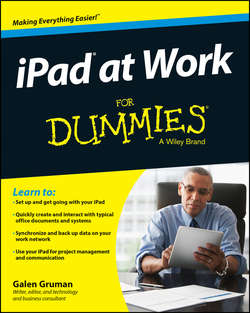Читать книгу iPad at Work For Dummies - Galen Gruman - Страница 9
На сайте Литреса книга снята с продажи.
Part I
Getting Started with iPad at Work
Chapter 2
Setting Up Your Own iPad for Work
Connecting to Wi-Fi
ОглавлениеWi-Fi is how any iPad can connect to the world, or at least to a router that serves as the bridge to the Internet.
In terms of using Wi-Fi, the iPad works like any computer: You scan for available networks or enter a Wi-Fi network’s name (called an SSID) and then its password. You do this by using the following steps:
1. In Settings, tap Wi-Fi.
Wait a few seconds for the available networks to appear.
Tap the Wi-Fi network you want to connect to, as shown in Figure 2-4.
If Wi-Fi is disabled, turn it on by sliding the Wi-Fi switch there.
3. Enter the password and tap Join. After you’ve joined a Wi-Fi network, the iPad will automatically rejoin it when it detects that network in the future.
Figure 2-4: Each mail account can have several business services available for use on the iPad.
In corporate environments, you may also be asked to accept a digital certificate. Doing so saves a file on your iPad that is like a second password that fills itself in for you, giving your network administrator extra assurance that your device is authorized when it later reconnects, as well as a way to keep track of the different devices that have connected.
In some corporate environments, Wi-Fi routers will also ask for additional credentials, usually the username and password you use at the office to access email and so forth (often called ActiveSync or Exchange credentials). Fill in what’s required to get that access.
In hotels, airports, and cafes, connecting to Wi-Fi is just the first step to gaining access to the Internet. Usually, after a few seconds, a Safari browser window opens, requiring you to sign up for (usually paid) access or enter your account credentials for that network’s provider. Sometimes all you have to do is accept some terms and conditions and look at an ad to get Internet access.
If you don’t seem to get Internet access after connecting to a Wi-Fi network in a commercial establishment, try opening Safari to see whether that forces the sign-up/sign-in pages to load. These pages don’t always load automatically from the Settings app.
After you’ve connected to a Wi-Fi network, the iPad automatically reconnects in the future when you get in range. But you still may need to go through a web sign-up form at a commercial establishment.
If you have a cellular iPad model, you don’t need to use Wi-Fi to connect to the Internet, though Wi-Fi is typically faster. My advice: Skip the high hotel, cafe, and airport Wi-Fi costs by using your cellular services in such locations, but definitely use Wi-Fi at work and home so that you don’t use up your cellular data allotment where you don’t have to. Hotels and airports often charge $10 to $30 a day for Wi-Fi access, which can add up to $100 or more per trip. By contrast, a 1GB or 2GB cellular plan – which provides plenty of data for email and other work uses – will cost just $20 to $30 for a month, and can be used in any location that has a cellular signal. Of course, if you do things like stream movies, you’ll eat up that cellular bandwidth fast – watching a single movie can take an entire gigabyte. So be sure to price the various scenarios to get the best option for your usage.
